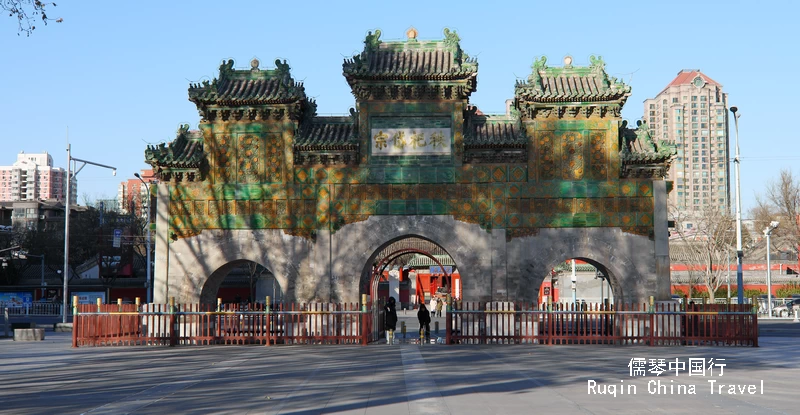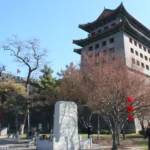Tucked away in the bustling heart of Chaoyang District, Beijing Dongyue Temple (Beijing Folklore Museum) offers a rare blend of peace, history, and tradition. Though surrounded by modern high-rises and busy avenues, this 700-year-old Taoist temple remains a quiet sanctuary—and a cultural treasure waiting to be explored.
Today, the temple also houses the Beijing Folklore Museum, which brings local customs to life through colorful exhibits, historical relics, and interactive displays. From festival traditions to family rituals, it’s a crash course in Chinese culture—all in one place.
This guide will help you make the most of your visit. We’ll cover the temple’s history, unique architecture, spiritual practices, and cultural highlights. Whether you’re a history lover, a spiritual seeker, or simply curious, this hidden gem offers something truly unforgettable.
1. Overview and Historical Background of Dongyue Temple
Just steps away from Beijing’s lively CBD, Dongyue Temple feels like a world apart. Tucked at No. 141 Chaoyangmen Outer Street, it offers calm and mystery in the middle of modern chaos. Locals often call it a “hidden sanctuary in the city.”
Beijing Dongyue Temple dates back to 1319 during the Yuan Dynasty. Taoist master Zhang Liusun (张留孙) and his disciple Wu Quanjie (吴全节) raised the funds to build it. Four years later, in 1323, the temple was completed and named “Dongyue Rensheng Palace.” (东岳仁圣宫) It honors the powerful God of Mount Tai—Dongyue Dadi, one of Taoism’s most respected deities.
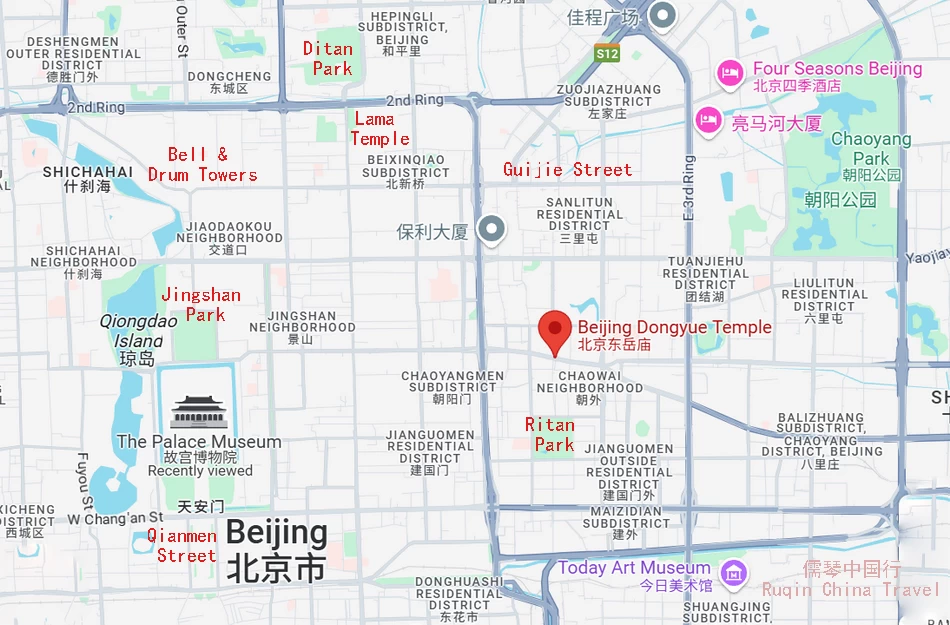
Over time,Beijing Dongyue Temple became the largest Zhengyi sect (正一派) temple in North China. During the Yuan, Ming, and Qing dynasties, both the imperial court and common people worshipped here. Even today, incense smoke still rises as worshippers come to pray.
Spanning around 71 mu (about 47,000 square meters), the temple holds nearly 400 rooms. Most were rebuilt in the Qing Dynasty. In 1996, it was named a national heritage site. What sets it apart is its rare mix of religious depth, folk culture, and architectural beauty.
Notably, it features the “Three Riches”—a sea of statues, couplets, and stone carvings. At its peak, it held over 3,000 divine figures, earning the nickname “apartment complex for immortals.” Today, it’s also home to Beijing’s only state-run museum of folk culture, offering travelers a rich, layered view of Chinese beliefs and traditions.
2. Architecture and Key Highlights of Dongyue Temple
Dongyue Temple follows a classic north-south central axis layout, just like the Forbidden City. As you move deeper into the complex, you’ll pass through six main courtyards. These include the Glazed Archway, Lingxing Gate, Zhandai Gate, Daiyue Hall, Yude Hall, and the Rear Hall. This “palace-style” setup shows just how important this temple was in ancient times.
🚪Glazed Archway and Main Gate
The Glazed Archway (琉璃牌楼), built in 1602 during the Ming Dynasty, is the temple’s most eye-catching feature. With bright yellow tiles, fierce animal carvings, and flame-shaped ornaments, it immediately grabs your attention. Stone plaques on both sides carry inscriptions, one of which is said to be written by the famous Ming official Yan Song.
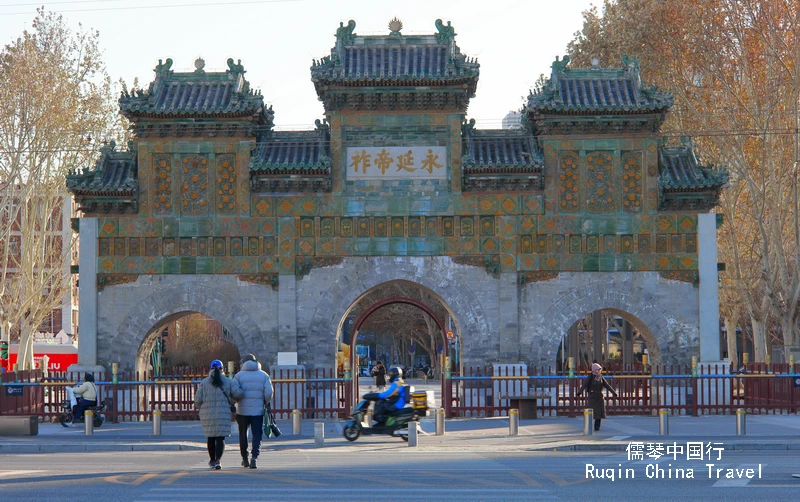
Next, the Lingxing Gate (棂星门) serves as today’s main entrance. It replaced the original mountain gate, which was demolished in 1988. Above it hangs an imperial plaque from Emperor Kangxi reading “Dongyue Temple.” Its three arches symbolize heaven, earth, and humanity—stepping through them means entering a spiritual world beyond the physical realm.
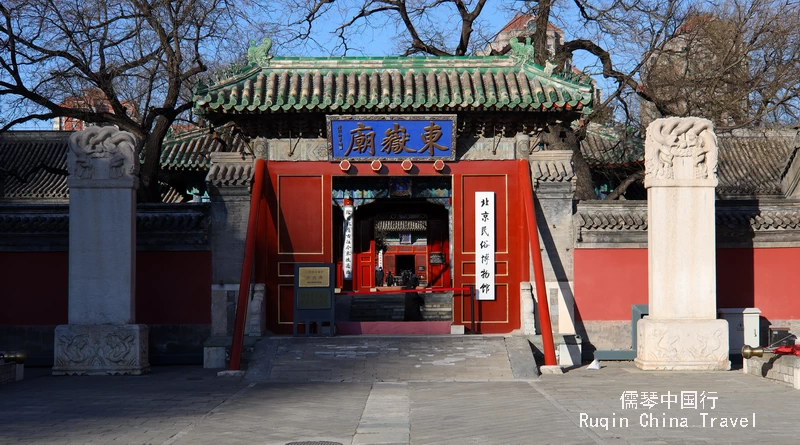
Passing through, you’ll arrive at Zhandai Gate (瞻岱门), also known as the Dragon-Tiger Gate. Inside, you’ll meet the temple’s fierce guardians—the Hum and Ha generals (哼哈二将). They represent the power to ward off evil with a mere breath. A striking couplet above reminds visitors that justice and karma are always watching.
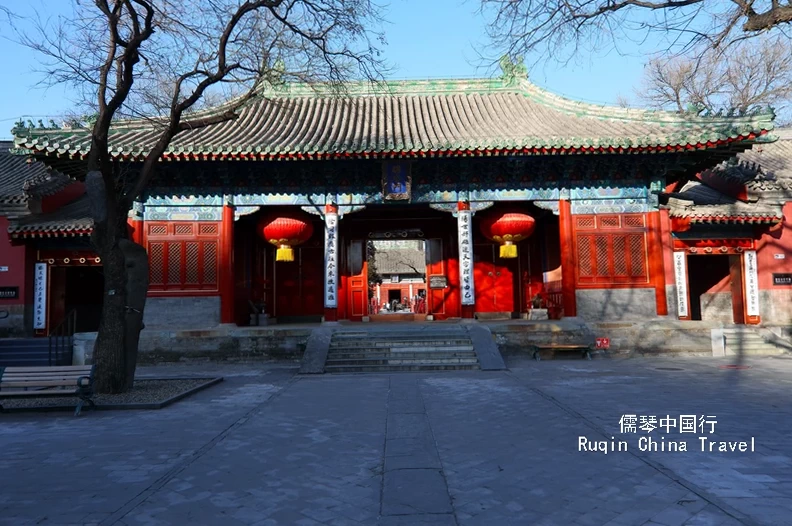
🧧 Blessings Road, Stone Steles, and Imperial Inscriptions
After Zhandai Gate, follow the Blessings Road (福路), which leads to the main hall. Each side is lined with bright red wishing plaques, creating a festive walkway—especially popular during Chinese New Year.
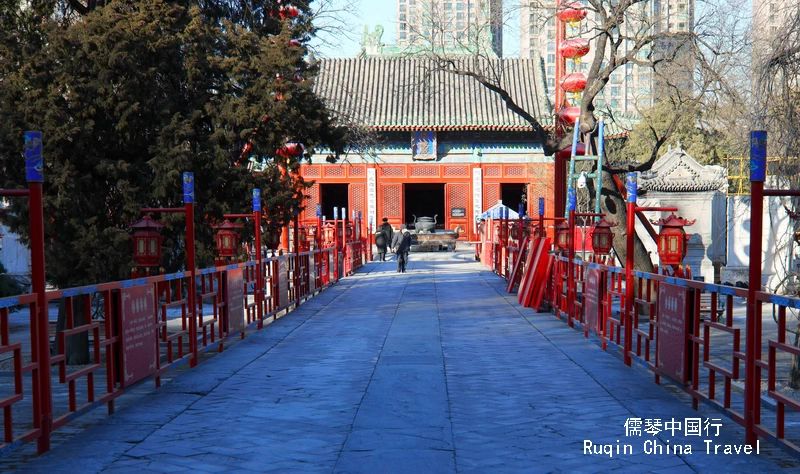
Flanking this road is the Stele Forest (碑林), home to 163 ancient stone tablets. Some showcase playful carvings like “The Clever Ghost” and “Little Gold Bean.”
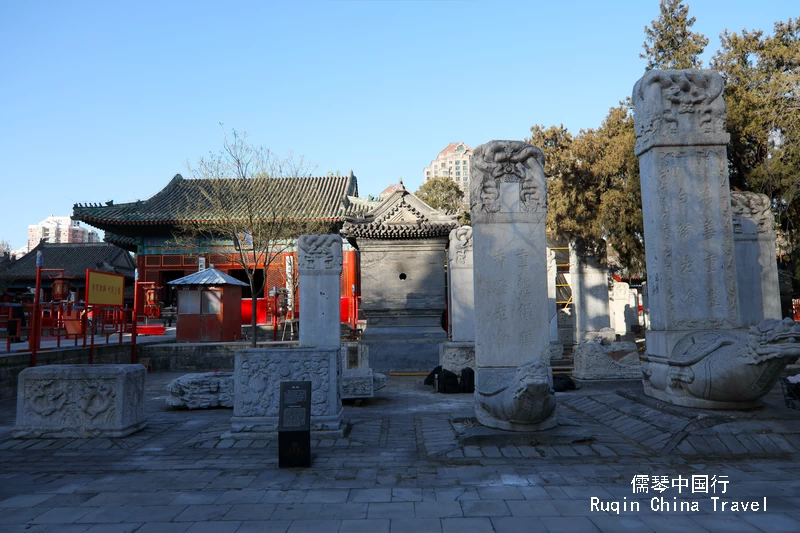
Others, like the Zhang Liusun Stele (张留孙道行碑), have deep historical value. This large, beautifully carved tablet records the temple’s founding story. It was written by Yuan dynasty calligrapher Zhao Mengfu and is now a top-grade cultural relic.
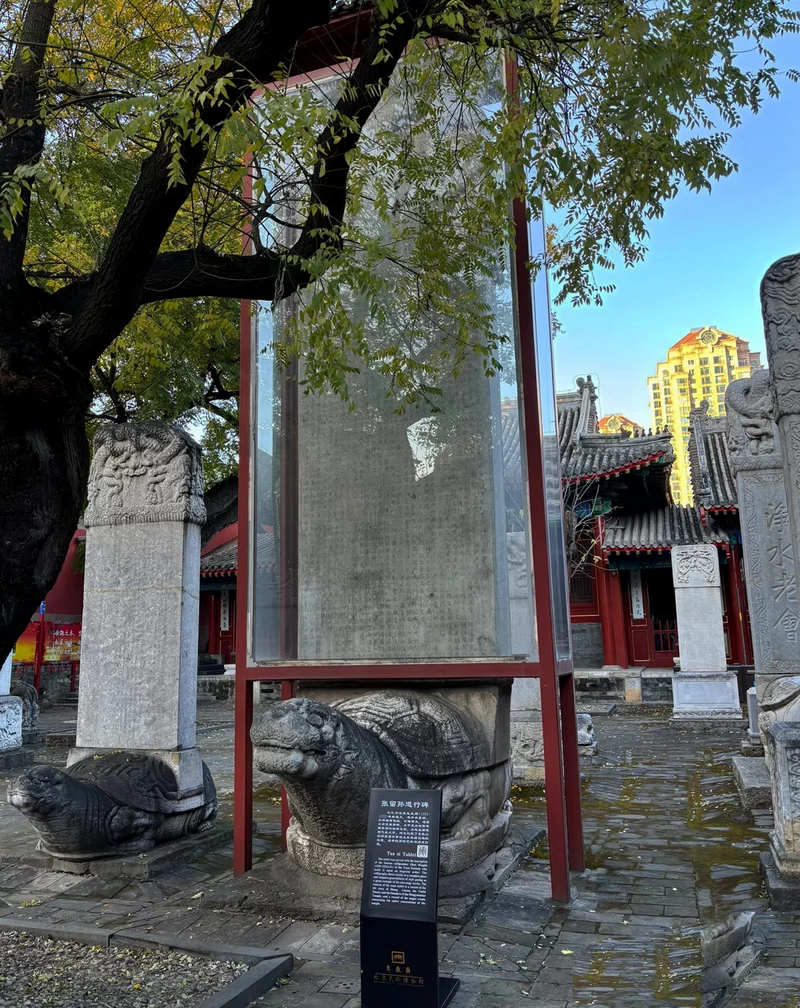
Nearby stands the Imperial Stele Pavilion (御碑楼), with stones inscribed by emperors Kangxi and Qianlong. Each rests on a stone turtle and features text in both Manchu and Chinese. These steles honor the temple’s significance through the centuries.

Don’t miss the odd-looking Jade Horse (玉马) and Bronze Special Beast (铜特). The bronze beast, with a donkey face, mule body, horse ears, and ox hooves, is said to cure illness.
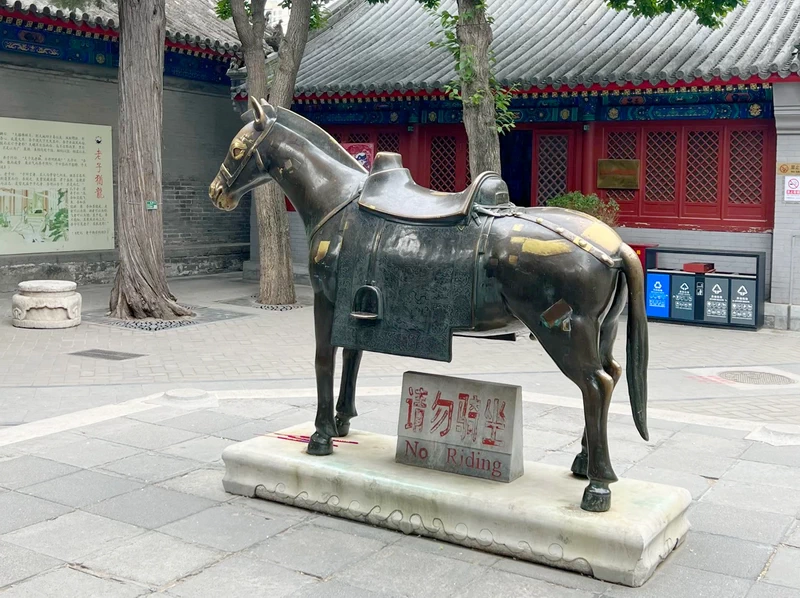
Locals believe that touching it brings good health—it’s one of Beijing’s “Three Lucky Touches,” (三摸) along with the Stone Fish at Tanzhe Temple and Stone Monkey at Baiyun Temple.
🐉 The Main Halls: Daiyue and Yude
The Daiyue Hall (岱岳殿) is the temple’s main hall. It has a green-tiled roof and golden dragon paintings—once reserved for the emperor. Inside stood a massive golden statue of Dongyue Emperor, seated in full ceremonial dress, holding a scepter. He governs life and death, fortune and fate. In front of the hall, a rare striped stone forms part of the temple’s “Four Uniques”—charming carved details known as the Clever Ghost, Little Gold Bean, Transparent Stele, and the Not-at-a-Loss Stone.

Behind it lies Yude Hall (育德殿), once the resting place of Dongyue Emperor. Now, it enshrines the Three Officials—the heavenly, earthly, and water officials. They bless, forgive sins, and remove misfortune. The layout here mirrors the Forbidden City’s front-court, rear-palace design, symbolizing divine authority.
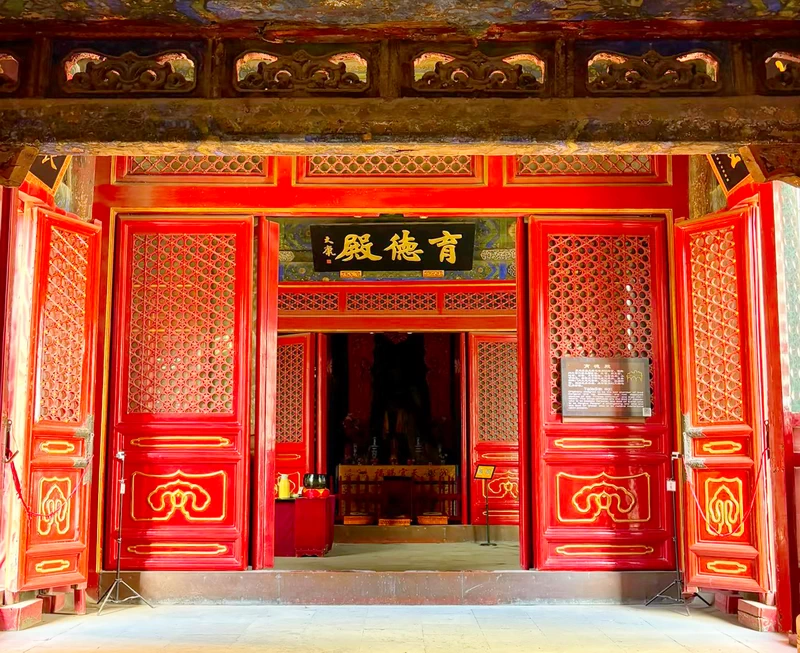
🏮 Rear Hall and Side Courtyards
Finally, at the temple’s back stands the Rear Hall (后罩楼), a two-story structure. It once held shrines to Jade Emperor, Bixia Yuanjun (Dongyue Emperor’s daughter), Guandi, Wenchang, Zaojun (Kitchen God), and more. Three rooms below were used by emperors as resting quarters when visiting or en route to royal tombs.
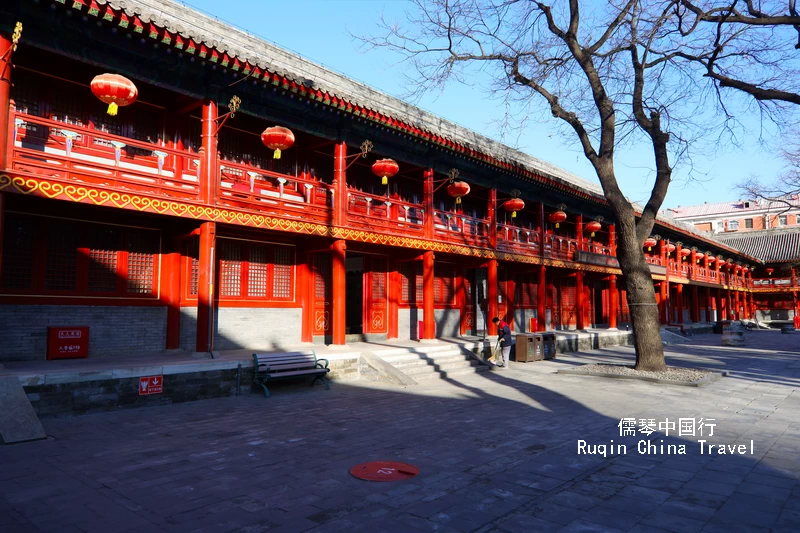
Today, The Rear Hall (后罩楼),has taken on a new life. It now houses part of the Beijing Folklore Museum, turning sacred space into a vibrant cultural showcase. Inside, you’ll find artifacts grouped into five main themes. First, there’s traditional clothing, including robes, shoes, and hats from various dynasties. Next, explore items linked to old Beijing’s business life, from shop signs to street vendor gear.

In another section, you’ll discover objects related to life rituals, such as weddings, births, and funerals. Further in, colorful displays celebrate seasonal festivals like Lunar New Year and Mid-Autumn. Finally, the museum offers a look at traditional games and pastimes, including toys, shadow puppets, and more.
Altogether, these exhibits help visitors connect with the rhythm of everyday life in old Beijing—offering a fun and meaningful cultural experience right inside the temple walls.
🏵️The East Courtyard and West Courtyard
To the east, the East Courtyard is peaceful and garden-like. Pavilions, strange rocks, and rare plants fill the space. According to legend, Empress Dowager Cixi and Emperor Guangxu once strolled here.
In contrast, the West Courtyard bursts with vibrant folk beliefs. Small shrines to the Medicine King, Horse King, Luban (patron of carpenters), and more reflect common people’s prayers. In the Fortune Hall, gods of wealth await offerings. At the Offspring Hall, visitors still pray for children—guided by the smiling deities known as Grandpa and Grandma Fertility.
3. The Taoist Belief System at Dongyue Temple
Dongyue Temple isn’t just about ancient buildings—it’s also home to one of Taoism’s most complex spiritual systems. At its heart is the Dongyue Emperor ( or Dongyue Dadi) (东岳大帝), the powerful god of Mount Tai, who oversees life, death, and fate. However, he’s not alone.
Next to him are other key deities, including the Three Mao Lords 三茅真君 (founders of the Shangqing School of Taoism), the Third Prince Bingling 炳灵公 , and the Three Officials 三官大帝 of Heaven, Earth, and Water. Together, they form a vast divine network, each with specific powers and responsibilities.
But the real highlight is the “76 Departments” system (“七十六司”体系). Lining both sides of the main hall, 72 rooms (actually 76) represent the underworld’s judgment offices, all under Dongyue Emperor’s command. Each department has a specific task—judging good and evil, managing wealth, recording birth and death, and more. It’s like a heavenly bureaucracy for the spirit world.
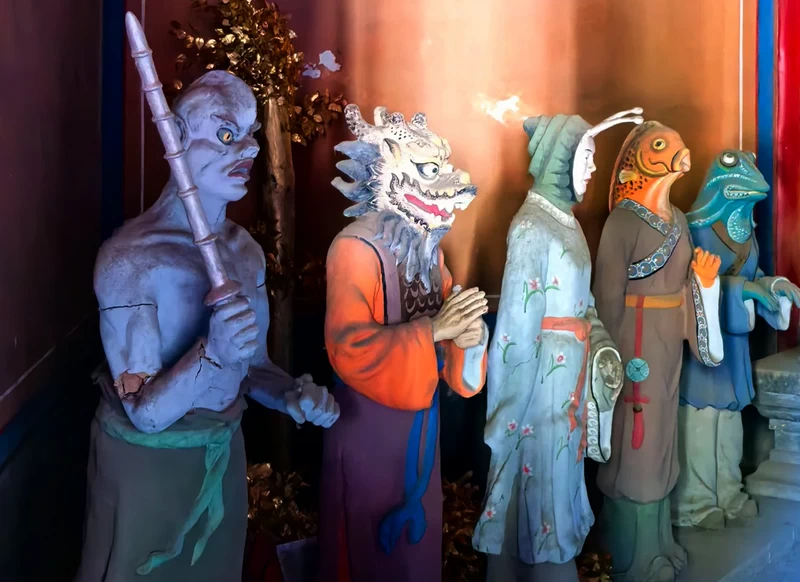
Additionally, powerful couplets hang above each door. Phrases like “Lust leads to all evil; Filial piety leads all virtue” (万恶淫为首,百善孝当先) offer moral reminders rooted in Taoist ethics.
Dongyue Temple is also famous for its “Three Abundances”—a multitude of statues (once over 3,000), dozens of poetic couplets, and more than 160 ancient stone inscriptions—the most of any temple in Beijing.
Among them, the most treasured piece is a Yuan dynasty stele written by the famous calligrapher Zhao Mengfu. Commissioned by the emperor, this stele honors Taoist master Zhang Liusun and details the temple’s founding. In 2001, it was officially recognized as a national first-class cultural relic.
4. Practical Visitor Info & Travel Tips
To help you get the most out of your visit to Dongyue Temple, here’s a quick guide packed with useful info and local tips. From opening hours to seasonal advice, these suggestions will make your cultural journey smoother and more rewarding.
🕰️ Basic Info at a Glance
- Opening Hours: 8:30 AM – 4:30 PM daily (Closed on Mondays)
- Spring Festival Hours: Extended from the 1st to 6th day of Lunar New Year
- Tickets: RMB 10 (Half price for students), Optional guide service: RMB 40
- Visit Duration:
- Standard visit: 1.5–2 hours
- In-depth experience (including the folklore museum): 3–4 hours
- During temple fair: Half day recommended
- Best Seasons to Visit:
- Lunar New Year: Experience the colorful temple fair and blessing rituals
- Spring & Autumn: Mild weather, fewer crowds, ideal for slow exploration
🚇 Getting There
Dongyue Temple sits at No. 141 Chaoyangmen Outer Street (朝阳区朝阳门外大街141号), right in central Chaoyang District. It’s surprisingly easy to reach:
- By Subway: Take Line 2 or Line 6 to Chaoyangmen Station
- Exit A or B, then walk just a few minutes east to reach the temple gate
Whether you’re planning a quiet cultural walk or diving into festival excitement, Dongyue Temple is easy to add to your Beijing adventure.
Dongyue Temple may not be as famous as the Forbidden City or the Summer Palace, but it offers something truly unique—a rich blend of Taoist spirituality, folk culture, and old Beijing charm, all hidden in plain sight in the heart of the city.
Whether you’re wandering through the shadowy halls of the 76 Departments, admiring ancient stone steles, or tying a red prayer tag during the temple fair, every moment at Dongyue Temple feels personal and immersive. It’s not just a place to visit—it’s a place to feel.
So next time you’re in Beijing, carve out a few hours for this spiritual sanctuary. You’ll walk away with more than just photos—you’ll leave with insight into centuries of belief, tradition, and everyday life in China.

